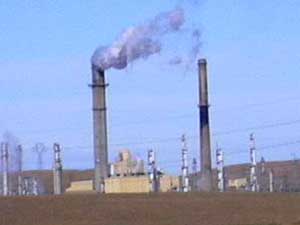|
Photos
Your Voice
|
North Dakota clean air dispute continues
November 10, 2003
 |
| State and federal reglators disagree on the amount of pollution coming from coal fired plants in North Dakota. (MPR Photo/Bob Reha) |
Beulah, N.D. — Beulah, is a small town in western North Dakota. It sits in the heart of what locals call, "coal country." There are seven huge coal burning plants in North Dakota. They generate electricty that's sent out of state. But they create pollution that stays right here.
Lignite coal contains high levels of sulfur dioxide. Sulfur dioxide creates a visible haze and can cause respiratory problems.
Walk into the local cafe and ask folks if they worry about pollution from the coal plants, and the answer might surprise you.
On the record, most folks will say, anonymously, the plants are doing a good job controlling pollution.
 | |||
"I think the plants are doing a wonderful job, I think they're doing a great job," says one man. Another chimes in, "I guess being here all my life, I really haven't seen any change."
But when you shut off the tape recorder, many folks will tell you, they're afraid to say what they really think. That doesn't surprise Don Beckel. He's farmed his entire life in the Beulah area.
"A lot of them are working at the plant or their business depends on the people that work there," says Beckel. "But more of the rural people that are out and about a lot, they definitely know the difference."
How to measure air pollution is a contentious issue in North Dakota. A citizens group is suing over the matter. The EPA and state regulators have different views on the issue.
The EPA uses computer models that show the coal-fired power plants have pumped too much sulfur dioxide into North Dakota's air. In fact the model shows the plants have released more than twice as much sulfur dioxide then federal law allows.
But North Dakota officials question the EPA's numbers. They say the computer modeling is flawed.
 | |||
State pollution data comes from monitoring equipment. But some of the machines are installed at Theodore Roosevelt National Park. That's 80 miles upwind from the coal plants.
Air pollution in the National Park is held to a more stringent level. Because of that, the EPA doesn't consider that data when it assesses the state's overall air quality.
Terry O'Clair, director of the North Dakota Health Department's air quality division, says the monitors are the truest assessment of air quality. In fact he says the air quality in the National Parks or Class 1 areas is good.
"We feel you need to do a reality check and look at monitors as well," says O'clair. "We do have monitors in the Class 1 areas and those monitors show that things have not gotten any worse, in fact they have improved in the last 20 years."
Coal industry leaders support the state health department. They say North Dakota's air quality is good. John Dwyer, president of the North Dakota Lignite Energy Council, says air monitors are the best way to assess air quality.
The EPA has refused to adopt North Dakota's argument. The state health department won't concede to the EPA's point of view. For the past four years the two sides have been trying to negotiate a settlement.
John Dwyer says the dispute is affecting plans to build two new coal-fired plants in North Dakota.
"Any uncertainty causes investors not to want to go forward with the plant," says Dwyer. "So while we believe that we can permit new clean coal facilities in North Dakota this kind of dispute doesn't help that."
The stalemate prompted a citizens group to sue the EPA. President of the Dakota Resource Council, Dean Hulse, says their lawsuit is an attempt to make the EPA do it's job and force the plants to reduce their pollution.
"I guess I can only conclude that political appointees at the EPA in Washington D.C. are more interested in other things. In doing other things than what is mandated in the Clean Air Act," Hulse says.
Officials at the Environmental Protection Agency declined to be interviewed for this story because of the lawsuit. State officials have said they hope to reach an agreement on air quality standards very soon.
|
News Headlines
|
Related Subjects
|
